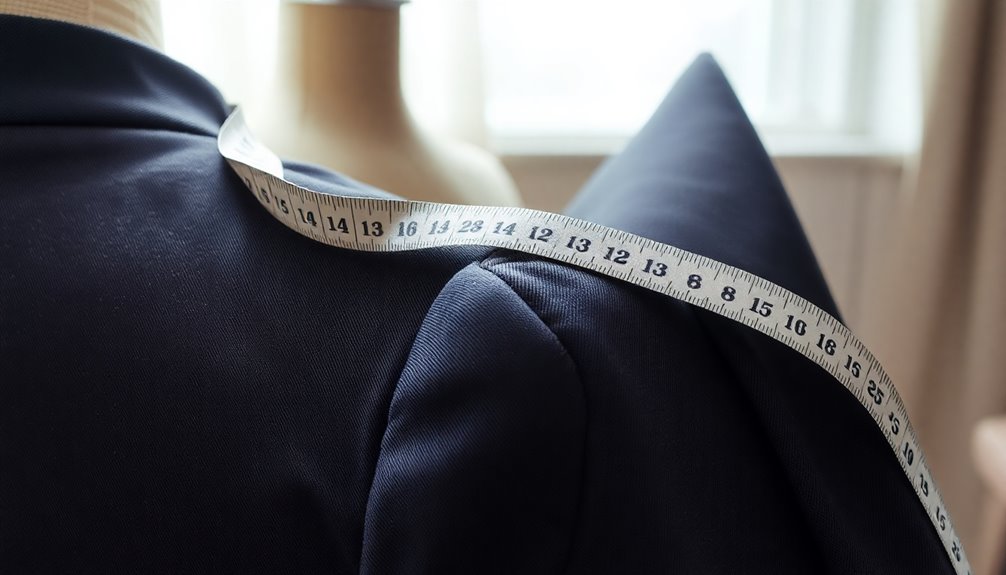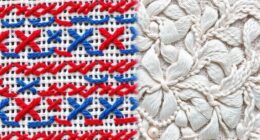Your shoulder seam should fall at the outer edge of your shoulder bone for the best fit and comfort. This placement guarantees smooth sleeve movement and enhances your garment's overall silhouette. Ideally, the seam should be about 0.5 inches wider than your natural shoulder, maintaining balance and preventing discomfort. Paying attention to these details can elevate your style. Want to learn more about achieving the perfect fit and customization trends for 2025?
Key Takeaways
- Shoulder seams should align with the outer edge of the shoulder bone for optimal fit and comfort.
- Ideally, the seam should fall 1 to 2 inches below the neckline for a balanced look.
- A shoulder width of about 0.5 inches wider than the natural shoulder ensures proper movement and style.
- Different seam types, like set-in or raglan, influence fit and silhouette; choose according to the garment's purpose.
- Adjustments by a tailor can correct misaligned seams, improving comfort and overall appearance of the garment.
Importance of Shoulder Seam Placement
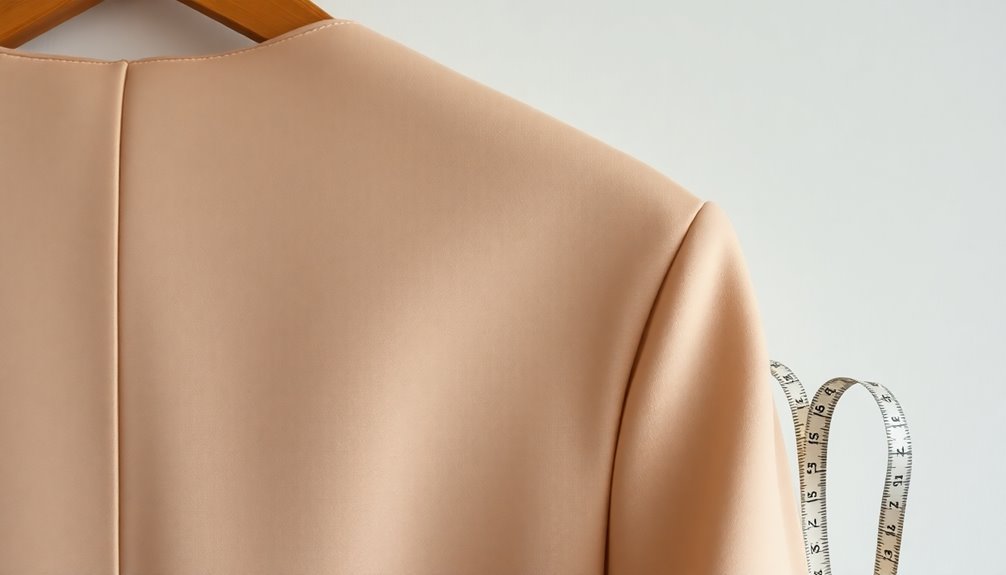
When it comes to achieving a tailored fit, the significance of shoulder seam placement can't be overstated. Proper shoulder seam placement guarantees that shoulder seams should align with the outer edge of your shoulder bone, allowing for comfortable movement and an ideal sleeve.
When done right, this attention to detail caters to your body shape, enhancing the overall silhouette of your garment. An ill-placed seam can lead to discomfort and an unflattering appearance, making it crucial for your suit to fit well.
Misalignment can create wrinkles and bulges, affecting quality. By prioritizing shoulder seam placement, you not only elevate your style but also embody a professional standard in tailoring, guaranteeing your look is polished and confident.
Ideal Shoulder Seam Characteristics
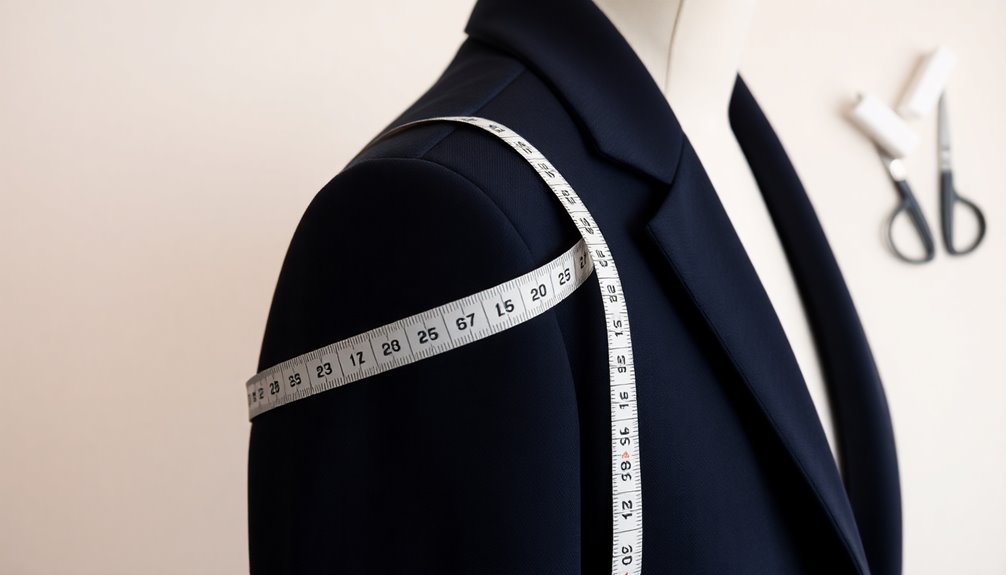
Achieving the perfect fit goes beyond just the placement of shoulder seams; it also involves understanding their ideal characteristics.
The ideal shoulder seam should align with the outer edge of your shoulder bone, allowing for a comfortable range of motion without any pulling or tension. For jackets, the shoulder width should be about 0.5 inches wider than your natural shoulder to guarantee proper fit.
An accurate shoulder seam placement meets the top of the sleeve smoothly, avoiding wrinkles or bulges. Balance is key; seams that are too narrow or wide can lead to discomfort and an unflattering silhouette.
Ultimately, the right shoulder seam enhances the overall appearance, garment drape, and boosts your style and confidence.
Types of Shoulder Seams
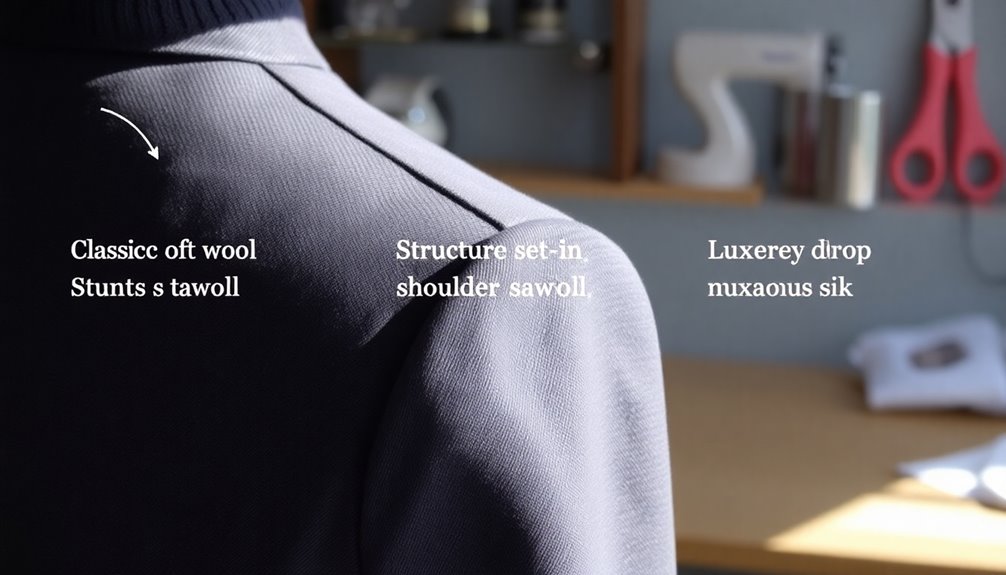
Understanding the different types of shoulder seams can greatly impact the fit and style of your garments.
The Set-In Shoulder Seam offers a tailored look, perfect for dress shirts and formal wear, ensuring the fit right along your natural shoulder line.
If you need flexibility, the Raglan Shoulder Seam extends diagonally from the collar to the underarm, ideal for activewear.
For casual tops, the Dolman Shoulder Seam provides a relaxed fit, while the Drop Shoulder Seam creates an oversized silhouette, perfect for layering.
Ultimately, the Kimono Shoulder Seam allows for seamless movement, offering comfort and appearance in loose-fitting garments.
Each seam type caters to various body types and enhances your overall shoulder design, ensuring you look stylish and feel great.
Common Issues and Adjustments for Shoulder Seams

Improperly placed shoulder seams can cause a range of fitting issues that affect both comfort and appearance. Common issues include uneven shoulder height, puckering, and restricted arm movement, all stemming from improper fit.
To guarantee proper shoulder seam placement, measure the distance from the base of your neck to the top of your shoulder, aligning the seam with your shoulder bone. Signs of poor fit, like wrinkles or bulges, often indicate that adjustments are needed.
Tailors can help by reshaping, moving, or shortening the seam for a more customized fit, particularly for unique body shapes. Addressing these concerns will improve both the look and comfort of your garments, allowing for ease without compromising style. Additionally, ensuring that your sewing practices are eco-friendly can contribute to a more sustainable wardrobe. When considering garment alterations, it may also be beneficial to learn how to select a sewing machine that suits your skill level and project needs. A reliable sewing machine can make the process of adjustments much easier, helping you achieve those tailored looks efficiently. Furthermore, investing in quality tools not only enhances your creativity but also promotes a more sustainable approach to fashion by encouraging you to repair and upcycle your wardrobe instead of discarding items.
Guidelines for Achieving the Perfect Fit

To guarantee your shoulder seams fit perfectly, start by aligning them with the outer edge of your shoulder bone. This guarantees comfortable mobility and an overall polished look.
Here are some key guidelines to take into account:
- Take accurate measurements from the base of your neck to the top of your shoulder.
- Aim for your shoulder seam to fall 1 to 2 inches below the neckline.
- Choose a suit jacket that balances shoulder seam width—too narrow or wide can lead to excess fabric and discomfort.
- Account for body shape variations to find styles that complement your features.
- Confirm sleeve length works harmoniously with your shoulder seam for a tailored garment appearance.
Follow these tips, and you'll achieve that perfect fit!
Measuring Techniques and Impact of Shoulder Slope
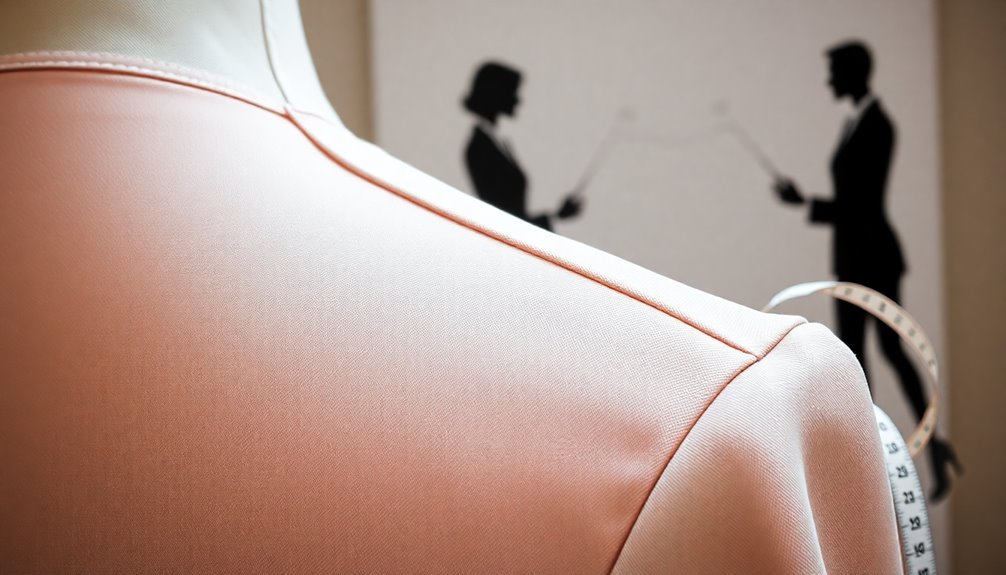
When measuring for shoulder seams, it's important to take into account the unique slope of your shoulders, as this directly affects fit and comfort.
Start by measuring from the bony edge of your shoulder, ensuring the shoulder seam aligns with the anatomical shoulder point for best fit. A high upper back measurement is important, as it influences the shoulder slope and overall fit. This measurement should be taken vertically from shoulder bone to shoulder bone.
Adjustments may be necessary based on your body shape, especially if the curve varies. Additionally, front measurements across the collarbone can reveal discrepancies in shoulder width perception, making careful assessment significant for achieving the perfect suit with custom suits that feel comfortable.
Customization Trends in 2025
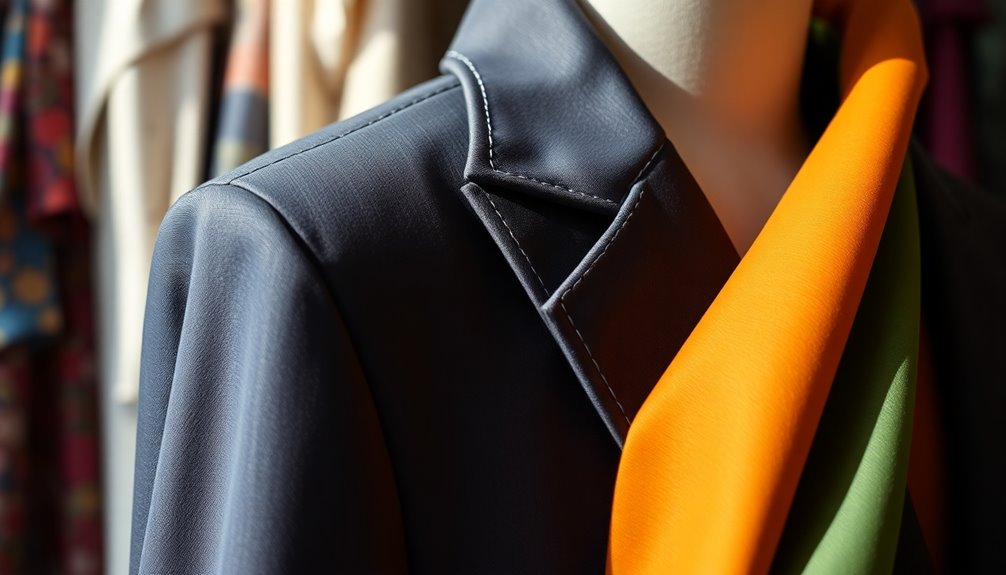
As we move into 2025, you'll notice a significant shift towards personalized fit solutions in menswear.
Innovations in tailoring technology are making it easier than ever to achieve that perfect fit, especially around the shoulder seams.
With these advancements, you can expect a more comfortable and stylish experience tailored just for you.
Personalized Fit Solutions
In 2025, personalized fit solutions revolutionize how you experience clothing, thanks to cutting-edge body scanning technology that tailors garments to your exact measurements.
You can now enjoy:
- Custom-tailored garments that hug your body perfectly
- Made-to-measure services that let you select your favorite eco-friendly fabrics
- Accurate fitting recommendations from advanced online platforms
- Expert guidance on ideal shoulder seam placement for enhanced comfort
- Personalized consultations with style experts to refine your overall garment fit
These innovations cater to your unique preferences and body contours, ensuring each piece feels uniquely yours.
With this focus on customization, you'll not only look great but also embrace sustainable fashion practices, contributing to a healthier planet.
Tailoring Technology Innovations
With the rapid evolution of tailoring technology, 2025 introduces groundbreaking innovations that redefine customization in fashion.
Precise body scanning allows you to achieve accurate measurements, enhancing your fit like never before. Smart fabrics are revolutionizing comfort, enabling real-time adjustments based on your body temperature and movement.
Thanks to digital pattern-making, tailors can create bespoke suits with meticulous attention to shoulder seam placement and overall fit. The rise of 3D printing technology offers intricate designs and personalized fittings you can truly call your own.
Plus, online fitting consultations, utilizing virtual reality and artificial intelligence, let you visualize and adjust shoulder seam placements before production. These advancements are akin to the way high refresh rates improve gaming experiences, ensuring every detail is perfectly tailored to your needs.
Embrace these advancements for a tailored experience that's uniquely yours!
Frequently Asked Questions
Where Should Shoulder Seams Fall?
When you're choosing a shirt, the shoulder seams should ideally fall right at the outer edge of your shoulder bone, aligning with your acromion. This placement guarantees a comfortable fit and a tailored look.
If you prefer a more relaxed style, consider a dropped shoulder seam, which sits lower and creates a breezy silhouette.
Keep in mind that proper seam alignment greatly affects sleeve movement and overall garment drape, so choose wisely!
Where Should Shoulder Seam Fall Coat?
When fitting a coat, you want the shoulder seam to align with the outer edge of your shoulder bone, typically around 1 to 2 inches below your neckline.
This placement guarantees a tailored fit and allows for comfortable movement. Aim for the seam to be about 0.5 inches wider than your natural shoulder to accommodate layering.
Proper alignment affects how the sleeves hang and the overall silhouette, so pay attention to these details.
Where Should the Shoulder Seam Sit on a Tshirt?
Imagine slipping on a t-shirt that fits like a dream, where the shoulder seam kisses the outer edge of your shoulder bone.
That's where it should sit! Ideally, it aligns with your acromion, about 1 to 2 inches below the neckline for a classic fit.
If you prefer a relaxed vibe, go for a drop shoulder seam that extends slightly beyond.
This way, you'll maintain a flattering silhouette and avoid any awkward puckering.
Where Should Suit Shoulders Fall?
When it comes to suit shoulders, you want the shoulder seam to align with the outer edge of your shoulder bone. This placement guarantees a tailored fit and allows for comfortable movement.
Ideally, the seam should rest at the acromion, giving your sleeves a proper hang without any pulling. For a classic look, aim for the seam to fall about 1 to 2 inches below your neckline for a neat silhouette.
Conclusion
In 2025, finding the perfect shoulder seam can feel like solving a puzzle, but it's worth the effort. When your shoulder seams align just right, you'll notice an instant boost in comfort and confidence. Coincidentally, as you embrace customization trends, you'll discover that minor adjustments can lead to major improvements. So, keep experimenting with different styles and measurements—your ideal fit is closer than you think, and it's waiting for you to make it happen!
